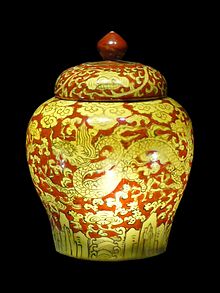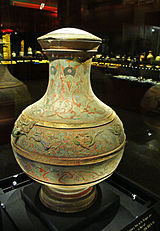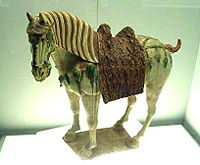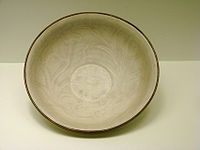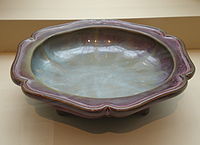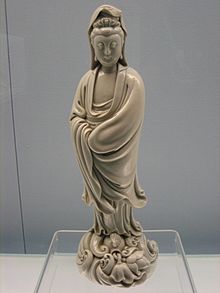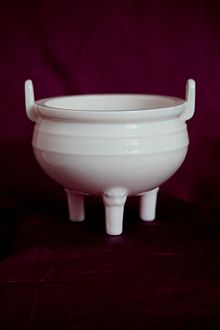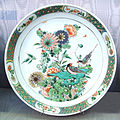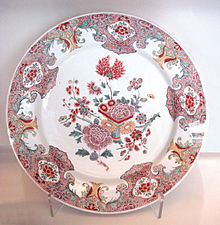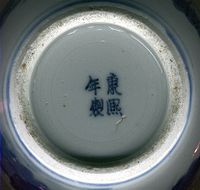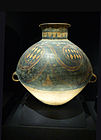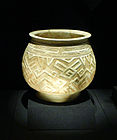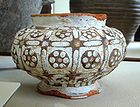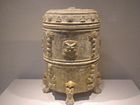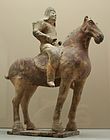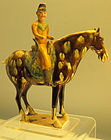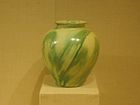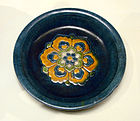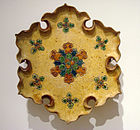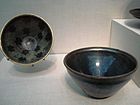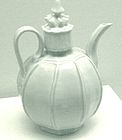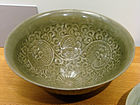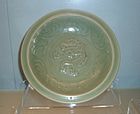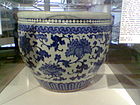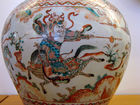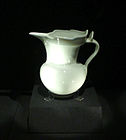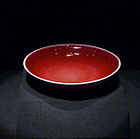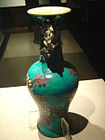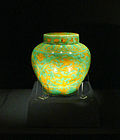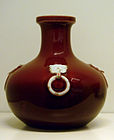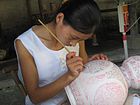- Chinese ceramics
-
Chinese ceramic ware shows a continuous development since the pre-dynastic periods, and is one of the most significant forms of Chinese art. China is richly endowed with the raw materials needed for making ceramics. The first types of ceramics were made during the Palaeolithic era. Chinese Ceramics range from construction materials such as bricks and tiles, to hand-built pottery vessels fired in bonfires or kilns, to the sophisticated Chinese porcelain wares made for the imperial court. China had a monopoly on porcelain production until relatively recently[vague], and porcelain is also often called "china" in English.
Introduction
Terminology and categories
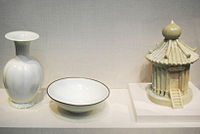 A qingbai porcelain vase, bowl, and model of a granary with transparent blue-toned glaze, from the period of the Song Dynasty (960-1279 AD).
A qingbai porcelain vase, bowl, and model of a granary with transparent blue-toned glaze, from the period of the Song Dynasty (960-1279 AD).
Porcelain "it is a collective term comprising all ceramic ware that is white and translucent, no matter what ingredients are used to make it or to what use it is put."[1] The Chinese tradition recognizes two primary categories of ceramics, high-fired [cí 瓷] and low-fired [táo 陶].[2] The oldest Chinese dictionaries define porcelain [cí 瓷] as "fine, compact pottery" [táo 陶].[3] Chinese ceramic wares can also classified as being either northern or southern. Present-day China comprises two separate and geologically different land masses, brought together by the action of continental drift and forming a junction that lies between the Yellow river and the Yangtze river. The contrasting geology of the north and south led to differences in the raw materials available for making ceramics.
Materials
Chinese porcelain is mainly made by a combination of the following materials:
- Kaolin - essential ingredient composed largely of the clay mineral kaolinite.
- Pottery stone - are decomposed micaceous or feldspar rocks, historically also known as petunse.
- Feldspar
- Quartz[4]
 A black pottery cooking cauldron from the Hemudu culture (c. 5000 – c. 3000 BC)
A black pottery cooking cauldron from the Hemudu culture (c. 5000 – c. 3000 BC)
Technical developments
In the context of Chinese ceramics, the term porcelain lacks a universally accepted definition. This in turn has led to confusion about when the first Chinese porcelain was made. Claims have been made for the late Eastern Han period (100 to 200 AD), the Three Kingdoms period (220 to 280 AD), the Six Dynasties period (220 to 589 AD), and the Tang Dynasty (618 to 906 AD).
Early wares
The Proceedings of the National Academy of Sciences in 2009 reports that pottery that dates back to 18,000 years ago in the Yuchanyan Cave in southern China has been found, making it among the earliest pottery yet found.[5] Fragments of pottery vessels dating from around 9000 BC found at the Xianrendong (Spirit Cave) site, Wannian County, in the province of Jiangxi represent some of the earliest known Chinese ceramics. The wares were hand-made by coiling and fired in bonfires. Decorations include impressed cord marks, and features produced by stamping and by piercing.
The Xianrendong site was occupied from about 9000 BC to about 4000 BC. During this period two types of pottery were made. The first consisted of coarse-bodied wares possibly intended for everyday use. The second being finer, thinner-bodied wares possibly intended for ritual use or special occasions. There is archaeological evidence suggesting that both types of wares were produced at the same time at some point.
Han dynasty, 202 BC-220 AD
Some experts believe the first true porcelain was made in the province of Zhejiang during the Eastern Han period. Shards recovered from archaeological Eastern Han kiln sites estimated firing temperature ranged from 1260 to 1300 °C.[6] As far back as 1000 BC, the so-called "Porcelaneous wares" or "proto-porcelain wares" were made using at least some kaolin fired at high temperatures. The dividing the line between the two and true porcelain wares is not a clear one. Archaelogical finds has pushed the dates to as early as the Han Dynasty (206 BC – 220 AD).[7]
The late Han years saw the early development of the peculiar art form of hunping, or "soul jar": a funerary jar whose top was decorated by a sculptural composition. This type vessels became widespread during the following Jin Dynasty and the Six Dynasties.[8]
Sui and Tang dynasties, 581-907
During the Sui and Tang periods (581 to 907) a wide range of ceramics, low-fired and high-fired, were produced. These included the well-known Tang lead-glazed sancai (three-colour) wares, the high-firing, lime-glazed Yue celadon wares and low-fired wares from Changsha. In northern China, high-fired, translucent porcelains were made at kilns in the provinces of Henan and Hebei.
One of the first mentions of porcelain by a foreigner was in the Chain of Chronicles written by the Arabian traveler and merchant Suleiman in 851 AD during the Tang Dynasty who recorded that:[7][9]
“ They have in China a very fine clay with which they make vases which are as transparent as glass; water is seen through them. The vases are made of clay. ” The Arabs were aware of the materials necessary to create glass ware, and he was certain that the porcelain that he saw was not the usual glass material.
Song and Yuan dynasties, 960-1368
The city of Jingdezhen (also Jingde Zhen) has been a central place of production since the early Han Dynasty. In 1004, Jingde established the city as the main production hub for Imperial porcelain. During the Song and Yuan dynasties, porcelain made in the city and other southern China kiln sites used crushed and refined pottery stones alone.
 Goldfish Vase, reign of the Jiajing Emperor (1521–67); Porcelain; Paris, Musée Guimet 261101
Goldfish Vase, reign of the Jiajing Emperor (1521–67); Porcelain; Paris, Musée Guimet 261101
Ming dynasty, 1368-1644
The Ming Dynasty saw an extraordinary period of innovation in ceramic manufacture. Kilns investigated new techniques in design and shapes, showing a predilection for colour and painted design, and an openness to foreign forms.[10] The Yongle Emperor (1402–24) was especially curious about other countries (as evidenced by his support of the eunuch Zheng He's extended exploration of the Indian Ocean), and enjoyed unusual shapes, many inspired by Islamic metalwork,[11][12][13] During the Xuande reign (1425–35), a technical refinement was introduced in the preparation of the cobalt used for underglaze blue decoration. Prior to this the cobalt had been brilliant in colour, but with a tendency to bleed in firing; by adding a manganese the colour was duller, but the line crisper. Xuande porcelain is now considered among the finest of all Ming output.[14] Enameled decoration (such as the one at left) was perfected under the Chenghua Emperor (1464–87), and greatly prized by later collectors.[15] Indeed by the late sixteenth century, Chenghua and Xuande era works – especially wine cups[16] – had grown so much in popularity, that their prices nearly matched genuine antique wares of Song or even older. This esteem for relatively recent ceramics excited much scorn on the part of literati scholars (such as Wen Zhenheng, Tu Long, and Gao Lian, who is cited below); these men fancied themselves arbiters of taste and found the painted aesthetic 'vulgar.'[17][18]
In addition to these decorative innovations, the late Ming period underwent a dramatic shift towards a market economy,[19] exporting porcelain around the world on an unprecedented scale. Thus aside from supplying porcelain for domestic use, the kilns at Jingdezhen became the main production centre for large-scale porcelain exports to Europe starting with the reign of the Wanli Emperor (1572–1620). By this time, kaolin and pottery stone were mixed in about equal proportions. Kaolin produced wares of great strength when added to the paste; it also enhanced the whiteness of the body - a trait that became a much sought after property, especially when form blue-and-white wares grew in popularity. Pottery stone could be fired at a lower temperature (1250 °C) than paste mixed with kaolin, which required 1350 °C. These sorts of variations were important to keep in mind because the large southern egg-shaped kiln varied greatly in temperature. Near the firebox it was hottest; near the chimney, at the opposite end of the kiln, it was cooler.
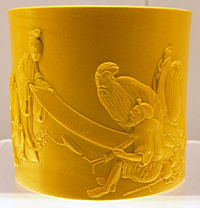 Yellow-glazed brush-holder, "Chen Guo Zhi" mark; Jingdezhen Daoguang reign, (1821-50); Shanghai Museum
Yellow-glazed brush-holder, "Chen Guo Zhi" mark; Jingdezhen Daoguang reign, (1821-50); Shanghai Museum
Qing dynasty, 1644-1911
Primary source material on Qing Dynasty porcelain is available from both foreign residents and domestic authors. Two letters written by Père Francois Xavier d'Entrecolles, a Jesuit missionary and industrial spy who lived and worked in Jingdezhen in the early eighteenth century, described in detail manufacturing of porcelain in the city.[20] In his first letter dated 1712, d'Entrecolles described the way in which pottery stones were crushed, refined and formed into little white bricks, known in Chinese as petuntse. He then went on to describe the refining of china clay kaolin along with the developmental stages of glazing and firing. He explained his motives:
“ Nothing but my curiosity could ever have prompted me to such researches, but it appears to me that a minute description of all that concerns this kind of work might, be useful in Europe. ” In 1743, during the reign of the Qianlong Emperor, Tang Ying, the imperial supervisor in the city produced a memoir entitled "Twenty illustrations of the manufacture of porcelain." Unfortunately, the original illustrations have been lost, but the text of the memoir is still accessible.[21]
Types of Chinese porcelain wares
Tang Sancai burial wares
Main article: SancaiSancai means three-colours. However, the colours of the glazes used to decorate the wares of the Tang dynasty were not limited to three in number. In the West, Tang sancai wares were sometimes referred to as egg-and-spinach by dealers for the use of green, yellow and white. Though the latter of the two colours might be more properly described as amber and off-white / cream.
Sancai wares were northern wares made using white and buff-firing secondary kaolins and fire clays.[22] At kiln sites located at Tongchuan, Neiqui county in Hebei and Gongxian in Henan,[22] the clays used for burial wares were similar to those used by Tang potters. The burial wares were fired at a lower temperature than contemporaneous whitewares. Burial wares, such as the well-known representations of camels and horses, were cast in sections, in moulds with the parts luted together using clay slip. In some cases, a degree of individuality was imparted to the assembled figurines by hand-carving.
Jian tea wares
Jian blackwares, mainly comprising tea wares, were made at kilns located in Jianyang of Fujian province. They reached the peak of their popularity during the Song dynasty. The wares were made using locally-won, iron-rich clays and fired in an oxidising atmosphere at temperatures in the region of 1300 °C. The glaze was made using clay similar to that used for forming the body, except fluxed with wood-ash. At high temperatures the molten glaze separate to produce a pattern called hare's fur. When Jian wares were set tilted for firing, drips run down the side, creating evidence of liquid glaze pooling.
The hare's fur Jian tea bowl illustrated in the Metropolitan Museum of Art in New York was made during the Song dynasty (960 to 1279 AD) and exhibits the typical pooling, or thickening, of the glaze near the bottom. The hare's fur patterning in the glaze of this bowl resulted from the random effect of phase separation during early cooling in the kiln and is unique to this bowl. This phase separation in the iron-rich glazes of Chinese blackwares was also used to produce the well-known oil-spot, teadust and partridge-feather glaze effects. No two bowls have identical patterning. The bowl also has a dark brown iron-foot which is typical of this style. It would have been fired, probably with several thousand other pieces, each in its own stackable saggar, in a single-firing in a large dragon kiln. One such kiln, built on the side of a steep hill, was almost 150 metres in length, though most Jian dragon kilns were fewer than 100 metres in length.
An 11th century resident of Fujian wrote:
“ Tea is of light colour and looks best in black cups. The cups made at Jianyang are bluish-black in colour, marked like the fur of a hare. Being of rather thick fabric they retain the heat, so that when once warmed through they cool very slowly, and they are additionally valued on this account. None of the cups produced at other places can rival these. Blue and white cups are not used by those who give tea-tasting parties.[3] ” At the time, tea was prepared by whisking powdered leaves that had been pressed into dried cakes together with hot water, (somewhat akin to matcha in Japanese Tea Ceremony). The water added to this powder produced a white froth that would stand out better against a dark bowl. Tastes in preparation changed during the Ming dynasty; the Hongwu Emperor himself preferred leaves to powdered cakes, and would accept only leaf tea as tribute from tea-producing regions. Leaf tea, in contrast to powdered tea, was prepared by steeping whole leaves in boiling water - a process that led to the invention of the teapot and subsequent popularity of Yixing wares over the dark tea bowls.[23]
Jian tea wares of the Song dynasty were also greatly appreciated and copied in Japan, where they were known as tenmoku wares.
Ding ware
Main article: Ding wareDing (Wade-Giles: Ting) ware was produced in Ding Xian (modern Chu-yang), Hebei Province, slightly south-west of Beijing. Already in production when the Song emperors came to power in 940, Ding ware was the finest porcelain produced in northern China at the time, and was the first to enter the palace for official imperial use. Its paste is white, generally covered with an almost transparent glaze that dripped and collected in "tears," (though some Ding ware was glazed a monochrome black or brown, white was the much more common type). Overall, the Ding aesthetic relied more on its elegant shape than ostentatious decoration; designs were understated, either incised or stamped into the clay prior to glazing. Due to the way the dishes were stacked in the kiln, the edged remained unglazed, and had to be rimmed in metal such as gold or silver when used as tableware. Some hundred years later, a Southern Song era writer commented that it was this defect that led to its demise as favoured imperial ware.[24] Since the Song court lost access to these northern kilns when they fled south, it has been argued that Qingbai ware (see below) was viewed as a replacement for Ding.[25]
Although not as highly ranked as Ru ware, the late Ming connoisseur Gao Lian awards Ding ware a brief mention in his volume Eight Discourses on the Art of Living. Classified under his sixth discourse, the section on “pure enjoyment of cultured idleness,” Master Gao says:
“ "The best sort has marks on it like tear-stains… Great skill and ingenuity is displayed in selecting the forms of the vessels…" [26] ” Ru Ware Bowl Stand, Chinese, Early 12th Century; Buff stoneware, with crackled light bluish green glaze, and a copper edge; London, Victoria and Albert Museum, FE.1-1970 [3]
Ru ware
Like Ding ware, Ru (Wade-Giles: ju) was produced in North China for imperial use. The Ru kilns were near the Northern Song capital at Kaifeng. In similar fashion to Longquan celadons, Ru pieces have small amounts of iron in their glaze that oxidize and turn greenish when fired in a reducing atmosphere. Ru wares range in colour—from nearly white to a deep robin's egg—and often are covered with reddish-brown crackles. The crackles, or "crazing," are caused when the glaze cools and contracts faster than the body, thus having to stretch and ultimately to split, (as seen in the detail at right; see also [6]). The art historian James Watt comments that the Song dynasty was the first period that viewed crazing as a merit rather than a defect. Moreover, as time went on, the bodies got thinner and thinner, while glazes got thicker, until by the end of the Southern Song the 'green-glaze' was thicker than the body, making it extremely 'fleshy' rather than 'bony,' to use the traditional analogy (see section on Guan ware, below). Too, the glaze tends to drip and pool slightly, leaving it thinner at the top, where the clay peeps through.
As with Ding ware, the Song imperial court lost access to the Ru kilns after it fled Kaifeng when the Jin invaded, and settled at Lin'an in Hangzhou, towards the south. There the Emperor Gaozong founded the Guan yao ('official kilns') right outside the new capital in order to produce imitations of Ru ware.[27] However, posterity has remembered Ru ware as something unmatched by later attempts; Master Gao says, "Compared with Guan yao, the above were of finer substance and more brilliant luster."[28]
Bulb Bowl with Scalloped Rim, Northern Song Dynasty (960-1127); Stoneware; Asian Art Museum, San Francisco, B60P93 [5]
Jun ware
Main article: Jun wareJun (Wade-Giles: chün) ware was a third style of porcelain used at the Northern Song court. Characterized by a thicker body than Ding or Ru ware, Jun is covered with a turquoise and purple glaze, so thick and viscous looking that it almost seems to be melting off its substantial golden-brown body. Not only are Jun vessels more thickly potted, their shape is much more robust than the fine Jun pieces, yet both types were appreciated at court of Emperor Huizong. Jun production was centered at Jun-tai in Yüzhou city, Henan Province.[24]
Guan ware
Guan (Wade-Giles: kuan) ware, literally means "official" ware; so certain Ru, Jun, and even Ding could be considered Guan in the broad sense of being produced for the court. Strictly speaking, however, the term only applies to that produced by an official, imperially-run kiln, which did not start until the Southern Song fled the advancing Jin and settled at Lin'an. It was during this period that walls become so thin and glaze so thick that the latter superseded the former in breadth. As the clay in the foothills around Lin'an, was a brownish colour, and the glaze so viscus, ‘’Guan’’ ware became known for its "brown mouth" (sometimes translated as "purple"), indicating the top rim or a vessel where the glaze is thinner and the body shows through.[29] Guan ceramics have been much admired over the years, and very subject to copy.[30] Indeed Gao Lain spends the greatest part of his commentary on describing Guan and its partner Ge ware (See below: though similar to Ge ware, Guan tends to have a bluer finish and a more translucent glaze),[31] as though that were the most troublesome, least easily identified type of pottery.[32]
Ge ware
Ge (Wade-Giles: ko), literally means 'big-brother' ware, because legend has it that of two brothers working in Longquan, one made the typical celadon style ceramics, but the elder made ge ware, produced in his private kiln. Ming commentator, Gao Lian claims that the ge kiln took its clay from the same site as Guan ware, which is what accounts for the difficulty in distinguishing one from the other (though Gao thinks "Ge is distinctly inferior" to Guan).[33] Overall, Ge remains somewhat elusive, but basically comprises two types—one with a ‘warm rice-yellow glaze and two sets of crackles, a more prominent set of darker colour interspersed with a finer set of reddish lines (called chin-ssu t’ieh-hsien or ‘golden floss and iron threads’, which can just faintly be detected on this bowl: [7]). The other Ge ware is much like Guan ware, with grayish glaze and one set of crackles. Once thought to have only been manufactured alongside Longquan celadon, per its legendary founding, Ge is now believed to have also been produced at Jingdezhen.[34]
While similar to Guan ware, Ge typically has a grayish-blue glaze that is fully opaque with an almost matte finish (as seen on this bottle in the Asian Art Museum [8]). Its crackle pattern is exaggerated, often standing out in bold black. Though still shrouded in mystery, many specialists believe that Ge ware did not develop until the very late Southern Song or even the Yuan. In any case, enthusiasm for it persisted throughout the Ming; Wen Zhenheng preferred it to all other types of porcelain, in particular for brush washers and water droppers (although he preferred jade brush washers to porcelain, Guan and Ge were the best ceramic ones, especially if they have scalloped rims). Differences between later Ming imitations of Song/Yuan Ge include: Ming versions substitute a white porcelain body; they tend to be produced in a range of new shapes, for example those for the scholar's studio; glazes tend to be thinner and more lustrous; and slip is applied to the rim and base to simulate the "brown mouth and iron foot" of Guan ware.[35]
Qingbai wares
Song Dynasty qingbai bowl
Qingbai wares (also called 'yingqing')[36] were made at Jingdezhen and at many other southern kilns from the time of the Northern Song Dynasty until they were eclipsed in the 14th century by underglaze-decorated blue and white wares. Qingbai in Chinese literally means "clear blue-white". The qingbai glaze is a porcelain glaze, so-called because it was made using pottery stone. The qingbai glaze is clear, but contains iron in small amounts. When applied over a white porcelain body the glaze produces a greenish-blue colour that gives the glaze its name. Some have incised or moulded decorations.
The Song dynasty qingbai bowl illustrated was likely made at the Jingdezhen village of Hutian, which was also the site of the Imperial kilns established in 1004. The bowl has incised decoration, possibly representing clouds or the reflection of clouds in the water. The body is white, translucent and has the texture of very-fine sugar, indicating that it was made using crushed and refined pottery stone instead of pottery stone and kaolin. The glaze and the body of the bowl would have been fired together, in a saggar, possibly in a large wood-burning dragon-kiln or climbing-kiln, typical of southern kilns in the period.
Though many Song and Yuan qingbai bowls were fired upside down in special segmented saggars, a technique first developed at the Ding kilns in Hebei province. The rims of such wares were left unglazed but were often bound with bands of silver, copper or lead.
One remarkable example of qingbai porcelain is the so-called Fonthill Vase, described in a guide for Fonthill Abbey published in 1823
“ "...an oriental china bottle, superbly mounted, said to be the earliest known specimen of porcelain introduced into Europe" ” The vase was made at Jingdezhen, probably around 1300 and was sent as a present to Pope Benedict XII by one of the last Yuan emperors of China, in 1338. The mounts referred to in the 1823 description were of enamelled silver-gilt and were added to the vase in Europe in 1381. An 18th century water colour of the vase complete with its mounts exists, but the mounts themselves were removed and lost in the 19th century. The vase is now in the National Museum of Ireland. It is often held that qingbai wares were not subject to the higher standards and regulations of the other porcelain wares, since they were made for everyday use. They were mass-produced, and received little attention from scholars and antiquarians. The Fonthill Vase, given by a Chinese emperor to a pope, might appear to cast at least some doubt on this view.
Blue and white wares
 Kangxi period (1662 to 1722) blue and white porcelain tea caddy
Kangxi period (1662 to 1722) blue and white porcelain tea caddy Main article: Blue and white porcelain
Main article: Blue and white porcelainFollowing in the tradition of earlier qingbai porcelains, blue and white wares are glazed using a transparent porcelain glaze. The blue decoration is painted onto the body of the porcelain before glazing, using very finely ground cobalt oxide mixed with water. After the decoration has been applied the pieces are glazed and fired.
It is believed that underglaze blue and white porcelain was first made in the Tang Dynasty. Only three complete pieces of Tang blue and white porcelain are known to exist (in Singapore from Indonesian Belitung shipwreck ), but shards dating to the 8th or 9th century have been unearthed at Yangzhou in the Jiangsu province. It has been suggested that the shards originated from a kiln in the province of Henan. In 1957, excavations at the site of a pagoda in the province Zhejiang uncovered a Northern Song bowl decorated with underglaze blue and further fragments have since been discovered at the same site. In 1970, a small fragment of a blue and white bowl, again dated to the 11th century, was also excavated in the province of Zhejiang.
In 1975, shards decorated with underglaze blue were excavated at a kiln site in Jiangxi and, in the same year, an underglaze blue and white urn was excavated from a tomb dated to 1319, in the province of Jiangsu. It is of interest to note that a Yuan funerary urn decorated with underglaze blue and underglaze red and dated 1338 is still in the Chinese taste, even though by this time the large-scale production of blue and white porcelain in the Yuan, Mongol taste had started its influence at Jingdezhen.
Starting early in the 14th century, blue and white porcelain rapidly became the main product of Jingdezhen, reaching the height of its technical excellence during the later years of the reign of the Kangxi Emperor[37] and continuing in present times to be an important product of the city.
The tea caddy illustrated shows many of the characteristics of blue and white porcelain produced during the Kangxi period. The translucent body showing through the clear glaze is of great whiteness and the cobalt decoration, applied in many layers, has a fine blue hue. The decoration, a sage in a landscape of lakes and mountains with blazed rocks is typical of the period. The piece would have been fired in a saggar (a lidded ceramic box intended to protect the piece from kiln debris, smoke and cinders during firing) in a reducing atmosphere in a wood-burning egg-shaped kiln, at a temperature approaching 1350 °C.
Distinctive blue-and-white porcelain was exported to Japan where it is known as Tenkei blue-and-white ware or ko sometsukei. This ware is thought to have been especially ordered by tea masters for Japanese ceremony.
Blanc de Chine
Main article: Blanc de ChineBlanc de Chine is a type of white porcelain made at Dehua in the Fujian province. It has been produced from the Ming Dynasty (1368–1644) to the present day. Large quantities arrived in Europe as Chinese Export Porcelain in the early 18th century and it was copied at Meissen and elsewhere.
The area along the Fujian coast was traditionally one of the main ceramic exporting centers. Over one-hundred and eighty kiln sites have been identified extending in historical range from the Song period to present.
From the Ming period porcelain objects were manufactured that achieved a fusion of glaze and body traditionally referred to as "ivory white" and "milk white." The special characteristic of Dehua porcelain is the very small amount of iron oxide in it, allowing it to be fired in an oxidising atmosphere to a warm white or pale ivory colour. (Wood, 2007)
The porcelain body is not very plastic but vessel forms have been made from it. Donnelly, (1969, pp.xi-xii) lists the following types of product: figures, boxes, vases and jars, cups and bowls, fishes, lamps, cup-stands, censers and flowerpots, animals, brush holders, wine and teapots, Buddhist and Taoist figures, secular figures and puppets. There was a large output of figures, especially religious figures, e.g., Guanyin, Maitreya, Lohan and Ta-mo figures.
The numerous Dehua porcelain factories today make figures and tableware in modern styles. During the Cultural Revolution "Dehua artisans applied their very best skills to produce immaculate statuettes of the Great Leader and the heroes of the revolution. Portraits of the stars of the new proletarian opera in their most famous roles were produced on a truly massive scale."[38] Mao Zedong figures later fell out of favour but have been revived for foreign collectors.
Notable artists in blanc de Chine, such as the late Ming period He Chaozong, signed their creations with their seals. Wares include crisply modeled figures, cups, bowls and joss stick-holders.
Many of the best examples of blanc de Chine are found in Japan where the white variety was termed hakugorai or "Korean white", a term often found in tea ceremony circles. The British Museum in London has a large number of blanc de Chine pieces, having received as a gift in 1980 the entire collection of P.J.Donnelly.[39]
Classification by colour, Famille
Commonly used French terms for 'families', or palettes of enamel colours used on Chinese porcelain. Famille jaune, noire, rose, verte are terms used to classify Chinese porcelain by its colour palette.
Famille verte
 Saint-Cloud soft porcelain spitting bowl, "Famille verte", 1730-1740.
Saint-Cloud soft porcelain spitting bowl, "Famille verte", 1730-1740.
Famille verte (康熙五彩, Kangxi wucai, also 素三彩, Susancai), adopted in the Kangxi (1662–1722), uses green and iron red with other overglaze colours. It developed from the Wucai (五彩, "Five colors") style.
Famille jaune
Famille jaune is a variation using famille verte enamels on a yellow ground.
Famille noire
Famille noire (Chinese: 黑地素三彩, Modi susancai) uses a black ground (although some clobbered wares had the black added in the 19th century).
Famille rose
Famille rose (known in Chinese as Fencai (粉彩) or Ruancai (軟彩, simplified 软彩), meaning 'soft colours', and later as Yangcai (洋彩), meaning 'foreign colours') was introduced during the reign of Kangxi (1654–1722), possibly around 1720. It used mainly pink or purple and remained popular throughout the 18th and the 19th centuries.
Famille rose enamel ware allows a greater range of colour and tone than was previously possible, enabling the depiction of more complex images, including flowers, figures and insects.
It is made by drawing a sketch on the shaped clay, which is then covered with 'glassy white' (bo li bai), an opaque white enamel (lead arsenate), and painted in detail with the mixture of pigment and oil, before firing.
-
Qing period Chinese export porcelain with European figure, Famille Rose, first half of 18th century.
-
Jingdezhen soft paste porcelain flower holder, "Famille Rose", 1736-1796, Qianlong period.
-
Saint-Cloud soft paste porcelain flower holder, "Famille Rose", 1730-1740.
Sandy clay ware or stoneware
Early pots were designed for travel use hence you will see the simple classical look of the pots produced during the Ming Dynasty. [40] Most tea drinking enthusiast will have one teapot for travel use, these tend to be less expensive and compact in design. It was not until during the mid-Qing Dynasty (18th century) that tea connoisseurs started to use the pot at home and the artisan begin to form them into different shape and sizes. Many exotic forms were conceived. Vessels were decorated with poetic inscriptions, calligraphy, paintings and seals were incised onto the surface of the teapots.
Types of sandy clay ware
The term "yixing clay", and also "sandy clay", is often used as an umbrella term to describe three distinct types of stoneware:
- purple sandy clay or purple clay (紫砂 or 紫泥): dark brownish stoneware that gives its name to the type of stoneware usually related to yixing.
- red sandy clay (朱泥; literally, "cinnabar clay"): reddish brown stoneware that is made from sandy clay with a very high iron content. The name only refers to the sometimes bright red hue of cinnabar (朱砂; pinyin: zhūshā). There are currently 10 mines still producing zhuni. However, due to the increasing demand for Yixing stoneware, zhuni is now in very limited quantities. Red sandy clay is not to be confused with Red clay (红泥, literally, "red clay"), another red clay.
- beige sandy clay (鍛泥; literally, "fortifed clay"): stoneware that was formulated using various stones and minerals in addition to zini or red sandy clay. This results in various textures and colours, ranging from beige, blue, and green (绿泥), to black.
Fakes and reproductions
 Italian pottery of the mid-15th century shows heavy influences from Chinese ceramics. A Sancai ("Three colors") plate (left), and a Ming-type blue-and-white vase (right), made in Northern Italy, mid-15th century. Musée du Louvre.
Italian pottery of the mid-15th century shows heavy influences from Chinese ceramics. A Sancai ("Three colors") plate (left), and a Ming-type blue-and-white vase (right), made in Northern Italy, mid-15th century. Musée du Louvre.
Chinese potters have a long tradition of borrowing design and decorative features from earlier wares. Whilst ceramics with features thus borrowed might sometimes pose problems of provenance, they would not generally be regarded as either reproductions or fakes. However, fakes and reproductions have also been made at many times during the long history of Chinese ceramics and continue to be made today in ever-increasing numbers.
- Reproductions of Song dynasty Longquan celadon wares were made at Jingdezhen in the early 18th century, but outright fakes were also made using special clay that were artificially aged by boiling in meat broth, refiring and storage in sewers. Père d'Entrecolles records that by this means the wares could be passed off as being hundreds of years old.[20]
- At Jingdezhen, the two remaining wood fired, egg-shaped kilns produce convincing reproductions of earlier wares. At Zhejiang province good reproductions of Song Longquan celedon wares continue to be made in large, side-stoked dragon kilns.[citation needed]
- Before World War II, the English potter Bernard Leach found what he took to be genuine Song dynasty cizhou rice-bowls being sold for very little money on the dock of a Chinese port and was surprised to learn that they were in fact newly made.[citation needed]
- In the late 19th century, fakes of Kangxi period famille noire wares were made that were convincing enough to deceive the experts of the day. Many such pieces may still be seen in museums today, as may pieces of genuine Kangxi porcelain decorated in the late nineteenth century with famille noire enamels. A body of modern expert opinion holds that porcelain decorated with famille noire enamels was not made at all during the Kangxi period, though this view is disputed.[37]
- A fashion for Kangxi period (1662 to 1722) blue and white wares grew to large proportions in Europe during the later years of the 19th century and triggered the production at Jingdezhen of large quantities of porcelain wares that strike a resemblance to ceramics of earlier periods. Such blue and white wares were not fakes or even convincing reproductions, even though some pieces carried four-character Kangxi reign-marks that continue to cause confusion to this day. Kangxi reign-marks in the form shown in the illustration occur only on wares made towards the end of the 19th century or later, without exception.
Authentication
The most widely-known test is the thermoluminescence test, or TL test, which is used on some types of ceramic to estimate, roughly, the date of last firing. The TL test is carried out on small samples of porcelain drilled or cut from the body of a piece, which can be risky and disfiguring. For this reason, the test is rarely used for dating finely-potted, high-fired ceramics. TL testing cannot be used at all on some types of porcelain items, particularly high-fired porcelain.[citation needed]
Gallery
Early wares
-
Painted jar of the Majiayao culture, Late Neolithic period (3300 - 2200 BC)
-
Painted pot with frog motifs, Majiayao culture (2200 - 2000 BC)
-
Painted pot of Majiayao culture (2200 - 2000 BC)
-
Black pottery goblet of the Late Neolithic period from the Longshan culture, dated (ca. 2500 - 2000 BC)
-
White pottery pitcher from the Shandong Longshan culture, 2500–2000 BC
-
White pottery pot with geometric design, Shang dynasty (1600-1100 BC)
-
Earthenware vase, Eastern Zhou, 4th-3rd century BC, British Museum
-
A pottery bell from the Warring States Period (403–221 BC)
-
A painted pottery dou vessel with a dragon design from the Warring States Period (403-221 BC)
-
Soldiers from the Terracotta Army, interred by 210 BC, Qin Dynasty (221–206 BC)
Han (202 BC to 220 AD)
-
Ceramic sculptures with polychrome, from the 2nd century BC, Han Dynasty.
-
A Han celadon pot with mountain-shaped lid and animal designs
-
Two Western Han Dynasty terracotta vases with acrobats
-
A Western Han glazed pottery ding with taotie-faced door knocker designs
-
An Eastern Han ceramic candle-holder with animal figurines
Three Kingdoms, Jin, Southern and Northern Dynasties, Sui (220 to 618)
-
A celadon ceramic candle holder in the shape of a crouched lion, Three Kingdoms (220–265), made in Eastern Wu
-
A celadon hunping jar with sculpted designs of architecture, from the Jin Dynasty (265-420)
-
A black-glazed wine or water jug with a rooster-headed spout, Jin Dynasty (265-420)
-
A footed earthenware lamp with lions, from either the Northern dynasties or Sui Dynasty, 6th century
-
Covered footed earthenware vessel from the Northern Qi (550–577)
-
Northern Dynasties lotus vessel
-
A Western Wei (536–556) ceramic figurine of a military officer
-
A ceramic cavalryman with a horn, Northern Wei (386–534)
Tang (618 to 906 AD)
-
Sancai-horse and figurine, Tang Dynasty
-
A Western on a Bactrian Camel, a sancai glazed figurine from the Tang Dynasty
Song (960 to 1279 AD)
-
Chinese tea bowls made of stoneware, Song Dynasty, 12th to 13th century
-
A porcelain teapot in Qingbai Style, from Jingdezhen
-
Funerary vase and cover, green-glazed stoneware, Northern Song (960–1127)
-
A Longquan celadon vase from the Song Dynasty
-
A celadon bowl, 10th-11th century
-
Longquan celadon wares, 13th century
-
Southern Song Dynasty celadon vase with dish shaped mouth, Longquan Ware
-
A glazed stoneware pillow from the Song Dynasty
-
A Song-era amphora with dragon handles
Yuan (1279 to 1368 AD)
-
A celadon shoulder pot from the late Yuan Dynasty, displaying artwork of peaches, lotuses, peonies, willows, and palms
-
A Jin or Yuan dynasty stoneware dish, 13th-14th century
-
Longquan celadon, 13th-14th century
-
A covered jar made of Longquan celadon, 14th century
-
A Jun ware bowl
Ming (1368 to 1644 AD)
-
Guanyin (Goddess of Mercy) with children, statuette made of Dehua porcelain ware
-
A Ming Dynasty porcelain bowl with flower designs
-
Ming presentation porcelain, Ming Dynasty (1368–1644) Fifteenth century
-
Porcelain plate from 1634, during the Chongzhen Emperor (1627–1644)
-
Porcelain vase from the reign of the Jiajing Emperor (1521–1567)
-
A Ming glazed earthenware statue of a seated Buddha
-
Ming Dynasty Yongle reign monk's cap white pitcher
-
Yongle reign red plate
-
Chrysanthemum styled porcelain vase with three colours
-
Jiajing covered jar with green dragon and cloud design
Qing (1644 to 1912 AD)
-
Kangxi transitional porcelain, 1644-1680
-
Kangxi transitional porcelain, 1644-1680
-
Porcelain plate from the reign of the Kangxi Emperor (1661–1722)
-
A porcelain bowl with a scene of two boys playing in a courtyard, from the reign of the Yongzheng Emperor (1722–1735)
-
Porcelain vase from the reign of the Kangxi Emperor (1661–1722)
-
Copper-red porcelain from the reign of the Yongzheng Emperor (1722–1735)
-
A European man on horseback, porcelain, first half of 18th century
-
Porcelain from the reign of the Qianlong Emperor (1735–1796)
-
Porcelain plate from the reign of the Qianlong Emperor (1735–1796)
-
Four ritual porcelain water vessels with elephant-trunk spouts, from the reign of the Qianlong Emperor (1735–1796)
-
An 18th-century Qing porcelain meiping (梅瓶; plum vase)
-
White porcelain from the reign of the Qianlong Emperor (1735–1796)
Republic and People's Republic (1912, to date)
See also
- Chinese art
- Blanc-de-Chine (the white wares of Dehua).
- Canton porcelain (Jingdezhen porcelain decorated at Canton for export to the West).
- Chinese export porcelain (Chinese porcelain made for export to the West).
- Dehua porcelain factories (the factories at Dehua).
- Famille jaune, noire, rose, verte (enamelled wares of the eighteenth and nineteenth centuries).
- Kraak porcelain (blue and white export wares in the Dutch taste).
- Longquan Celadon (the celadon wares of Longquan county).
- Swatow ware (wares exported through the port of Swatow).
- Yixing clay (the red stonewares of Yixing).
- Tiger Cave Kiln (site of much of Southern Song official celadon ware)
- Shiwan Ware
- Pinner
- Thai ceramics
- Vietnamese ceramics
References
- ^ An Introduction To The Technology Of Pottery. 2nd edition. Paul Rado. Pergamon Press, Institute of Ceramics. 1988.
- ^ Pierson, Stacey, (1996). Earth, Fire and Water: Chinese Ceramic Technology. Percival David Foundation of Chinese Art, University of London. ISBN 0-7286-0265-2.
- ^ a b Bushell, S. W. (1977) Chinese Pottery and Porcelain. Oxford University Press, Kuala Lumpur. ISBN 0-19-580372-8.
- ^ Kerr, Rose and Wood, Nigel (2004). Science and Civilisation in China, Volume 5, Part XII: Ceramic Technology. Cambridge University Press. ISBN 0-521-83833-9.
- ^ "Chinese pottery may be earliest discovered." Associated Press. 2009-06-01
- ^ He Li, (1996). Chinese Ceramics. The New Standard Guide. Thames and Hudson, London. ISBN 0-500-23727-1.
- ^ a b Temple, Robert K.G. (2007). The Genius of China: 3,000 Years of Science, Discovery, and Invention (3rd edition). London: André Deutsch, pp. 103-6. ISBN 9780233002026
- ^ Dien, Albert E. (2007), Six dynasties civilization, Early Chinese civilization series, Yale University Press, pp. 214–215, ISBN 0300074042, http://books.google.com.au/books?id=0zp6iMZoqt0C&pg=PA214
- ^ Bushell, S. W. (1906). Chinese Art. Victoria and Albert Museum Art Handbook, His Majesty's Stationery Office, London.
- ^ Lion-Goldschmidt, Ming Porcelain, pp. 20, 47.
- ^ Buddhist Ablution Basin, Asian Art Museum, http://67.52.109.59/code/emuseum.asp?style=browse¤trecord=1&page=search&profile=objects&searchdesc=b60p33&quicksearch=b60p33&newvalues=1&newstyle=single&newcurrentrecord=1.
- ^ Handled Ewer, Asian Art Museum, http://67.52.109.59/code/emuseum.asp?style=browse¤trecord=1&page=search&profile=objects&searchdesc=b60p85&quicksearch=b60p85&newvalues=1&newstyle=single&newcurrentrecord=2.
- ^ Li He and Michael Knight, Power and Glory: Court Art of China’s Ming Dynasty (San Francisco: Asian Art Museum, 2008), p. 130.
- ^ Watt, Possessing the Past, pp. 439-41.
- ^ James C.Y. Watt, “Official Art and Commercial Art,” in Possessing the Past, p. 441.
- ^ Wine cup, Met, http://www.metmuseum.org/toah/ho/08/eac/ho_1987.85.htm.
- ^ James C.Y. Watt, “The Literati Environment,” in The Chinese Scholar's Studio, pp. 1–13.
- ^ Craig Clunas, Superfluous Things: Material Culture and Social Status in Early Modern China. Urbana: University of Illinois Press, 1991 and Honolulu: University of Hawai'i Press, 2004.
- ^ On the development of a market system and its impact on material culture more generally, see Timothy Brook, The Confusions of Pleasure: Commerce and Culture in Ming China (Berkeley and Los Angeles: University of California Press, 1998).
- ^ a b see: Two letters written by Père Francois Xavier d'Entrecolles at Ceramics Today.com
- ^ Tang Ying's "Twenty illustrations of the manufacture of porcelain." at the Seattle Art Museum
- ^ a b Wood, Nigel (1999). Chinese Glazes. A.C. Black, London. ISBN 0-7136-3837-0
- ^ On shift from powdered to leaf tea and its accompanying accouterments, see Robert Mowry The Chinese Scholar's Studio: Artistic Life in the Late Ming period, ed. Chu-tsing Li et al., (New York: Thames and Hudson, 1987), p. 166; Timothy Brook, The Confusions of Pleasure: Commerce and Culture in Ming China, (Berkeley and Los Angeles: University of California Press, 1998), p. 127; and James C.Y. Watt, “Antiquarianism and Naturalism,” in Possessing the Past, p. 246.
- ^ a b James C.Y. Watt, “Antiquarianism and Naturalism,” in Possessing the Past, pp. 236–38.
- ^ ”Qingbai wine ewer and basin” The British Museum, http://www.britishmuseum.org/explore/highlights/highlight_objects/asia/q/qingbai_wine_ewer_and_basin.aspx
- ^ Gao Lian, “The ‘’Tsun Sheng Pa Chien’’, AD 1591, by Kao Lien,” tr. Arthur Waley, Yearbook of Oriental Art and Culture, 1, (1924-25), p. 86. See also Clunas, Superfluous Things, pp. 13-20.
- ^ James C.Y. Watt, “Antiquarianism and Naturalism,” in Possessing the Past, pp. 238–42.
- ^ Gao Lian, “The ‘’Tsun Sheng Pa Chien’’, AD 1591, by Kao Lien,” p. 82.
- ^ [1]
- ^ James C.Y. Watt, “Antiquarianism and Naturalism,” in Possessing the Past, pp. 243–4.
- ^ Robert Mowry The Chinese scholar's studio: artistic life in the late Ming period, eds. Chu-tsing Li et al., (New York: Thames and Hudson, 1987), p. 164
- ^ Gao Lian, “The ‘’Tsun Sheng Pa Chien’’, AD 1591, by Kao Lien,” pp. 82–4.
- ^ Gao Lian, “The ‘’Tsun Sheng Pa Chien’’, AD 1591, by Kao Lien,” p. 84–5.
- ^ James C.Y. Watt, “Antiquarianism and Naturalism,” in Possessing the Past, pp. 245–38.
- ^ Robert Mowry The Chinese scholar's studio, p. 164
- ^ Wood, Nigel, Chinese Glazes
- ^ a b de Boulay, Anthony (1973). Chinese Porcelain. Octopus Books, London. ISBN 0-7064-0045-3
- ^ (Ayers and Bingling, 2002)
- ^ (Harrison-Hall, 2001)
- ^ http://www.imperialteapots.com/servlet/the-template/guidetoyixingteapots/Page
Bibliography
- Ayers, J. and Bingling, Y., (2002) Blanc de Chine: Divine Images in Porcelain, China Institute, New York
- Ayers, J and Kerr, R., (2000), Blanc de Chine Porcelain from Dehua, Art Media Resources Ltd.
- Brook, Timothy. The Confusions of Pleasure: Commerce and Culture in Ming China. Berkeley and Los Angeles: University of California Press, 1998. ISBN 0-520-22154-0.
- Clunas, Craig. Superfluous Things: Material Culture and Social Status in Early Modern China. Urbana: University of Illinois Press, 1991 and Honolulu: University of Hawai'i Press, 2004.
- Donnelly, P.J. (1969), Blanc de Chine, Faber and Faber, London
- Fong, Wen C, and James C.Y. Watt. Possessing the Past: Treasures from the National Palace Museum Taipei. New York: The Metropolitan Museum of Art, 1996.
- Gao, Lian. “The Tsun Sheng Pa Chien, AD 1591, by Kao Lien.” Translated by Arthur Waley. Yearbook of Oriental Art and Culture, 1, (1924–25).
- Harrison-Hall, J. (2001), Ming Ceramics in the British Museum, British Museum, London
- Kerr, Rose and Wood, Nigel (2004). Science and Civilisation in China, Volume 5, Part XII: Ceramic Technology. Cambridge University Press. ISBN 0-521-83833-9.
- Kotz, Suzanne (ed.) (1989) Imperial Taste. Chinese Ceramics from the Percival David Foundation. Chronicle Books, San Francisco. ISBN 0-87701-612-7.
- Li, Chu-tsing and James C.Y. Watt, eds. The Chinese scholar's studio: artistic life in the late Ming period. New York: Thames and Hudson, 1987.
- Li, He, (1996). Chinese Ceramics. The New Standard Guide. Thames and Hudson, London. ISBN 0-500-23727-1.
- Li, He and Michael Knight. Power and Glory: Court Art of China’s Ming Dynasty. San Francisco: Asian Art Museum, 2008.
- Lion-Goldschmidt, Daisy. Ming Porcelain. Translated by Katherine Watson. New York: Rizzoli, 1978.
- Moujian, S., (1986) An Encyclopedia of Chinese Art, p. 292.
- Pierson, Stacey, (1996). Earth, Fire and Water: Chinese Ceramic Technology. Percival David Foundation of Chinese Art, University of London. ISBN 0-7286-0265-2.
- Wood, N. (2007), Chinese Glazes: Their Chemistry, Origins and Re-creation, A & C Black, London, and University of Pennsylvania Press, USA
External links
- Chinese Ceramics at China Online Museum
Categories:- History of ceramics
- Chinese porcelain
- Chinese art
- Chinese clay art
- Arts in China
Wikimedia Foundation. 2010.

